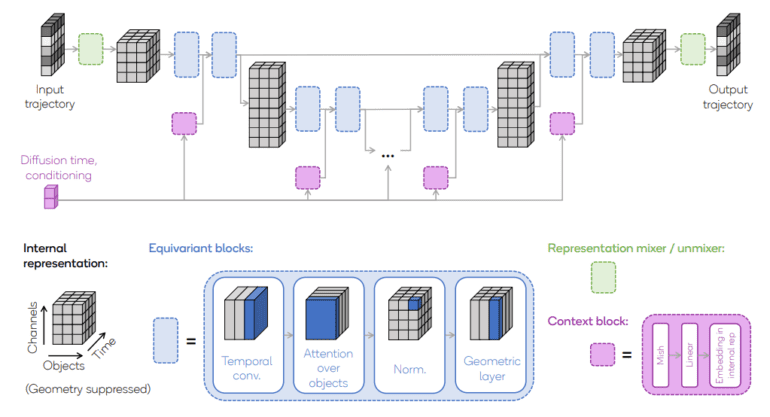TL;DR:
- Qualcomm AI Research introduces EDGI, an Equivariant Diffuser for Generating Interactions.
- Symmetries in physics and robotics inspire EDGI’s approach to reinforcement learning.
- EDGI addresses sampling inefficiency and environmental changes in RL algorithms.
- Two key requirements are equivariance to relevant symmetry groups and flexibility to break symmetry when needed.
- EDGI encompasses the entire product group SE(3) × Z × Sn for comprehensive adaptability.
- Built on the Diffuser method, EDGI utilizes diffusion models, classifiers, and conditional planning.
- A novel diffusion model supports multi-representation data and equivariance.
- EDGI enables a gentle breaking of symmetries based on test-time task requirements.
- Demonstrated superior performance with less training data and resilience to symmetry changes.
Main AI News:
In the realm of business and technological innovation, the symmetries that govern our physical world have long been a source of fascination and inspiration. From the elegant principles of physics to the intricacies of spatial and temporal coordination, these symmetries underpin our understanding of the universe. In the world of artificial intelligence and robotics, these symmetries play a crucial role in shaping the landscape of model-based reinforcement learning and efficient planning.
Embracing the profound connection between symmetries and intelligent agents, Qualcomm AI Research presents an extraordinary breakthrough known as the Equivariant Diffuser for Generating Interactions or EDGI for short. This cutting-edge method for model-based reinforcement learning and planning is poised to redefine the way businesses approach complex problem-solving and decision-making.
At the heart of EDGI lies a deep understanding of symmetries, both spatial and temporal. In a world where robotic systems engage with a multitude of objects and scenarios, it is imperative that algorithms possess the capability to adapt and leverage these symmetries effectively. Traditional approaches may yield impressive results with sufficient training, but they often fall short in terms of sampling efficiency and resilience to environmental fluctuations.
The research team at Qualcomm AI Research recognizes the pivotal importance of integrating symmetries into RL algorithms. To meet the evolving demands of the business world, EDGI is designed to fulfill two critical requirements. First, it ensures that world and policy models are equivariant with respect to pertinent symmetry groups, which may include discrete time shifts Z, spatial symmetry group SE(3), and object permutation groups Sn. Second, EDGI allows for a gentle breaking of symmetry when necessary, enabling tasks that require deviation from the norm.
In the pursuit of equivariant RL, previous works have primarily focused on finite symmetry groups like Cn, often lacking the flexibility required for real-world applications. EDGI, however, breaks new ground by encompassing the entire product group SE(3) × Z × Sn. This comprehensive approach anticipates the myriad representations of symmetries encountered in embodied contexts, making EDGI a powerful tool for businesses navigating diverse challenges.
The core methodology of EDGI builds upon the innovative Diffuser method, a framework that addresses the complexities of generative modeling while learning dynamics models and planning within them. At its essence, Diffuser leverages diffusion models trained on offline datasets of state-action trajectories. With the guidance of classifiers to optimize rewards, EDGI enables conditional planning based on the present state, facilitating adaptive decision-making.
A key breakthrough presented by the research team is a novel diffusion model capable of handling multi-representation data and equivariant to the product group SE(3) × Z × Sn, encompassing spatial, temporal, and permutation symmetries. EDGI introduces temporal, object, and permutation layers that act on individual symmetries, coupled with a revolutionary method for embedding multiple input representations into a unified internal representation.
When integrated with classifier guidance and conditioning, EDGI empowers businesses to gently break symmetries as dictated by test-time task requirements within their planning algorithms. To demonstrate its effectiveness, the research team conducted experiments in robotic item handling and 3D navigation settings. Remarkably, EDGI achieved superior performance with an order of magnitude less training data, rivaling the best non-equivariant baselines. Moreover, its ability to adapt to previously uncharted territories and resilience in the face of environmental symmetry changes underscores its potential as a game-changer in the business landscape.
Conclusion:
Qualcomm AI Research’s EDGI represents a groundbreaking leap in the world of model-based reinforcement learning and planning, with far-reaching implications for businesses seeking to enhance their decision-making processes. By harnessing the power of symmetries and introducing flexible equivariance, EDGI empowers businesses to navigate complex challenges with unprecedented efficiency and resilience. It is a testament to the ever-evolving intersection of artificial intelligence and business innovation, where symmetries pave the way for success in an increasingly dynamic world.

